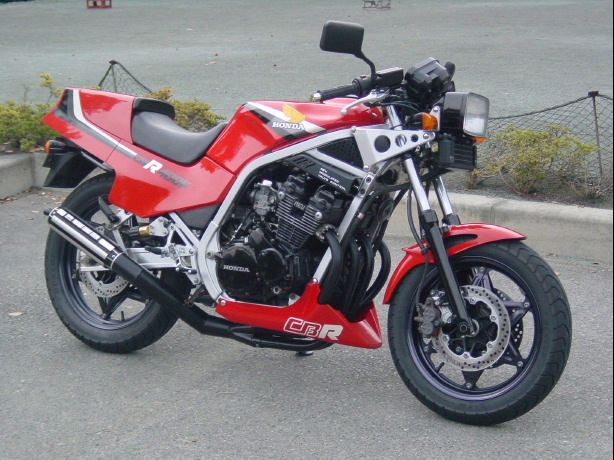First incarnation of the CBR400 came about in 1983 as the CBR400F NC17 as a naked bike. The CBR400F was launched in December 1983. The 4-valves per cylinder, air-cooled, four-stroke, DOHC, inline-four engine had a rotational-speed valve stop mechanism "REV" (a prototype of Honda's VTEC system) that changed from two valves into four valves at 9,500 rpm. The following two years, it came as semi- and fully faired version as the F3 Endurance. The CBR400R and early CBR400RR models both carry the model number NC23, which makes up the first part of these bikes' frame numbers. The early NC23 was designated CBR400R and is also known as Aero, Hurricane or Jellymould, as it shares its major design features with the rest of the early CBR family of motorcycles, which included significantly rounded body shapes, whereas the later NC23 is designated CBR400RR and is also known as the Tri-Arm, after its racing inspired braced swingarm.
The CBR400RR models, therefore, consist of the later NC23 CBR400RR-J (1988) and CBR400RR-K (1989) models as well as the NC29 CBR400RR-L (1990 & 1991), -N (1992 & 1993) and -R (1994 onwards). The name "Tri-Arm" is shown on the CBR400RR-J's bodywork, along with Hurricane, but the CBR400RR-K dropped the latter designation.
Honda CBR400RR-K in Repsol
Developed mostly for younger Japanese riders, the 400 cc (24 cu in) engine still had enough power to drive the bike up to a speed-limited 180 km/h (110 mph). The inline-four engine produces pleasing power anywhere in its rev range, and the bike is light and relatively easy to control. Outside the Japan, the CBR400RR was available only as a grey market import. The small capacity of the engine and manageability of the whole package makes this bike a favourite of new riders from all areas where the bike is available.
The DOHC cam gear train engine from the NC23 was later used in the NC29 and the CB400F CB-1, model number NC27, a naked bike that is credited with inspiring the popular 'Hornet' range. However the NC27 bears little mechanical resemblance to those machines and is probably the first true factory streetfighter.
In 2013, Honda released the new twin-cylinder CBR400R along with its naked model, the CB400F (not to be confused with four-cylinder CB400 Super Four), and sport adventure model, the CB400X, which is based on the CBR500R, CB500F, and CB500X respectively. These models is sold in Japan only.






0 Comments